1997 SSANGYONG KORANDO service indicator
[x] Cancel search: service indicatorPage 1412 of 2053
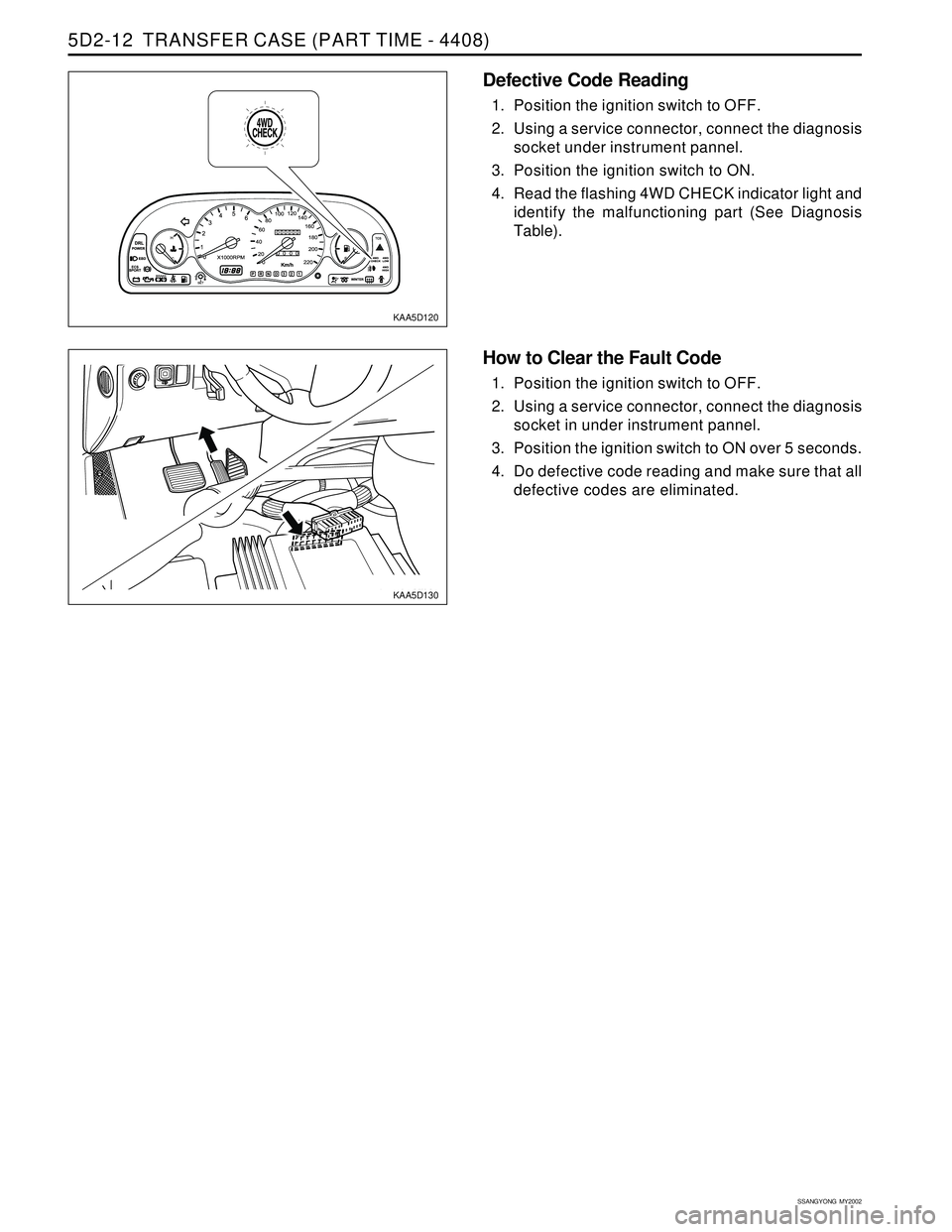
SSANGYONG MY2002
5D2-12 TRANSFER CASE (PART TIME - 4408)
KAA5D120
KAA5D130
Defective Code Reading
1. Position the ignition switch to OFF.
2. Using a service connector, connect the diagnosis
socket under instrument pannel.
3. Position the ignition switch to ON.
4. Read the flashing 4WD CHECK indicator light and
identify the malfunctioning part (See Diagnosis
Table).
How to Clear the Fault Code
1. Position the ignition switch to OFF.
2. Using a service connector, connect the diagnosis
socket in under instrument pannel.
3. Position the ignition switch to ON over 5 seconds.
4. Do defective code reading and make sure that all
defective codes are eliminated.
Page 1413 of 2053
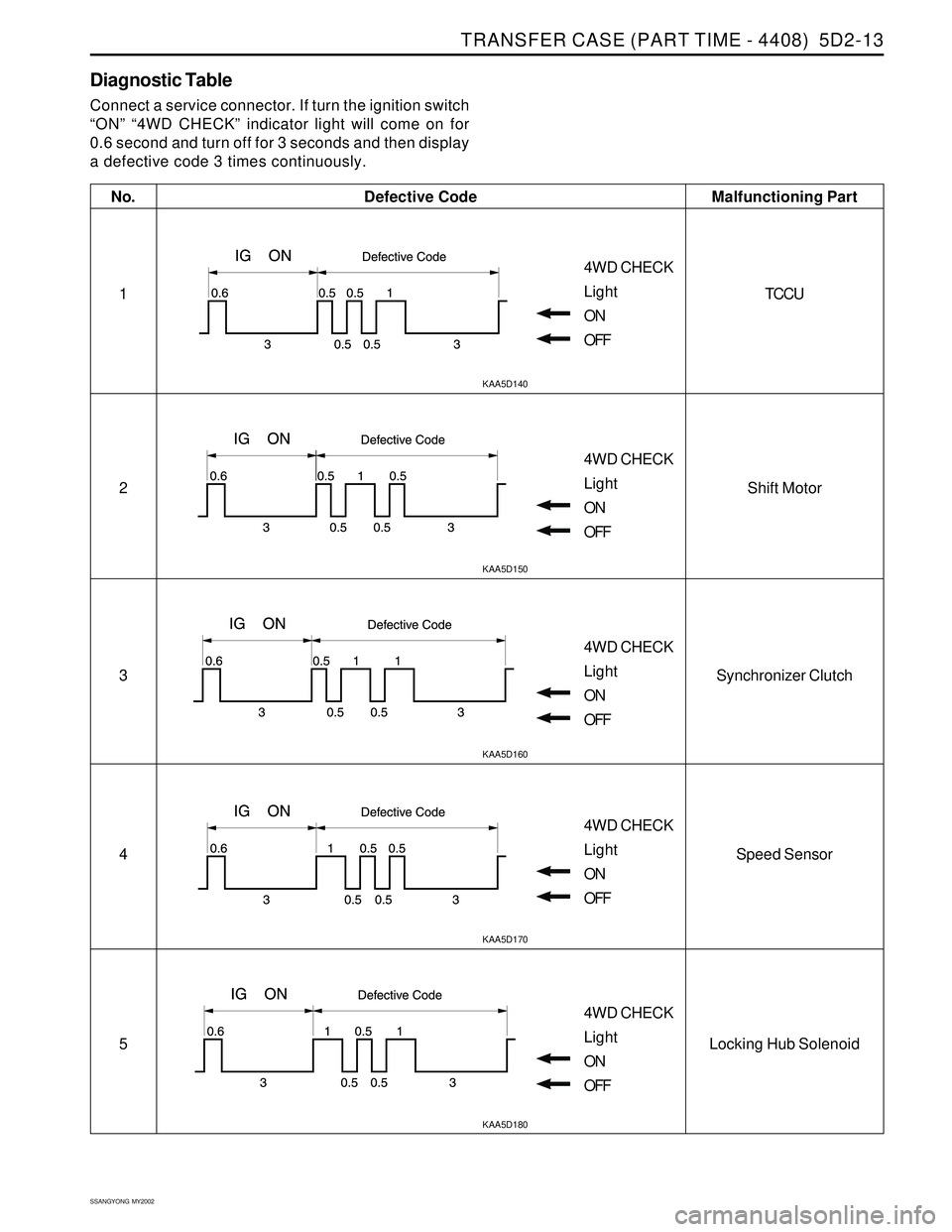
TRANSFER CASE (PART TIME - 4408) 5D2-13
SSANGYONG MY2002
Diagnostic Table
Connect a service connector. If turn the ignition switch
“ON” “4WD CHECK” indicator light will come on for
0.6 second and turn off for 3 seconds and then display
a defective code 3 times continuously.
4WD CHECK
Light
ON
OFF
4WD CHECK
Light
ON
OFF
4WD CHECK
Light
ON
OFF
4WD CHECK
Light
ON
OFF
4WD CHECK
Light
ON
OFFTCCU
Shift Motor
Synchronizer Clutch
Speed Sensor
Locking Hub Solenoid Defective Code No.
1
2
3
4
5
Malfunctioning Part
KAA5D140
KAA5D150
KAA5D160
KAA5D170
KAA5D180
Page 1589 of 2053
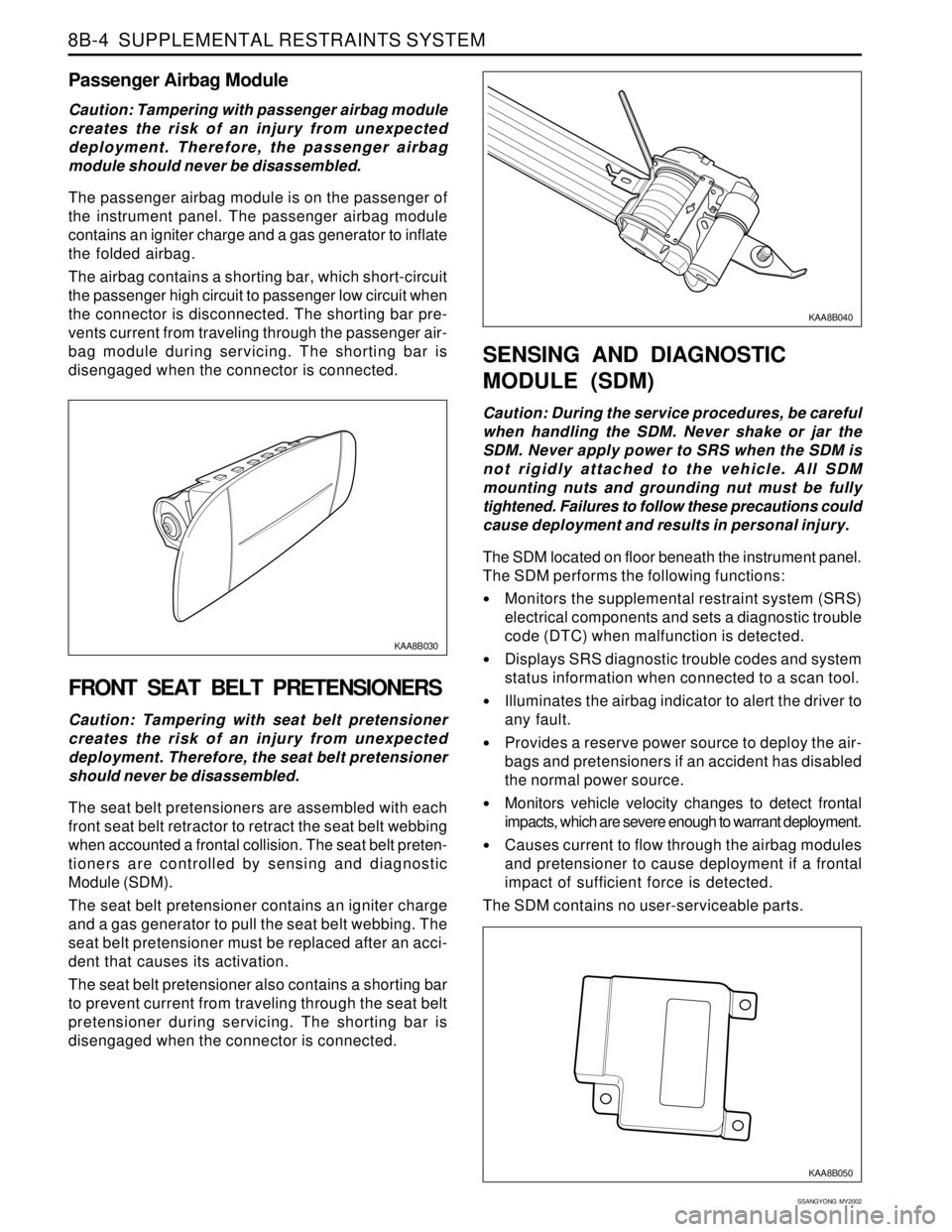
SSANGYONG MY2002
8B-4 SUPPLEMENTAL RESTRAINTS SYSTEM
KAA8B030
KAA8B040
Passenger Airbag Module
Caution: Tampering with passenger airbag module
creates the risk of an injury from unexpected
deployment. Therefore, the passenger airbag
module should never be disassembled.
The passenger airbag module is on the passenger of
the instrument panel. The passenger airbag module
contains an igniter charge and a gas generator to inflate
the folded airbag.
The airbag contains a shorting bar, which short-circuit
the passenger high circuit to passenger low circuit when
the connector is disconnected. The shorting bar pre-
vents current from traveling through the passenger air-
bag module during servicing. The shorting bar is
disengaged when the connector is connected.
FRONT SEAT BELT PRETENSIONERS
Caution: Tampering with seat belt pretensioner
creates the risk of an injury from unexpected
deployment. Therefore, the seat belt pretensioner
should never be disassembled.
The seat belt pretensioners are assembled with each
front seat belt retractor to retract the seat belt webbing
when accounted a frontal collision. The seat belt preten-
tioners are controlled by sensing and diagnostic
Module (SDM).
The seat belt pretensioner contains an igniter charge
and a gas generator to pull the seat belt webbing. The
seat belt pretensioner must be replaced after an acci-
dent that causes its activation.
The seat belt pretensioner also contains a shorting bar
to prevent current from traveling through the seat belt
pretensioner during servicing. The shorting bar is
disengaged when the connector is connected.
SENSING AND DIAGNOSTIC
MODULE (SDM)
Caution: During the service procedures, be careful
when handling the SDM. Never shake or jar the
SDM. Never apply power to SRS when the SDM is
not rigidly attached to the vehicle. All SDM
mounting nuts and grounding nut must be fully
tightened. Failures to follow these precautions could
cause deployment and results in personal injury.
The SDM located on floor beneath the instrument panel.
The SDM performs the following functions:
Monitors the supplemental restraint system (SRS)
electrical components and sets a diagnostic trouble
code (DTC) when malfunction is detected.
Displays SRS diagnostic trouble codes and system
status information when connected to a scan tool.
Illuminates the airbag indicator to alert the driver to
any fault.
Provides a reserve power source to deploy the air-
bags and pretensioners if an accident has disabled
the normal power source.
Monitors vehicle velocity changes to detect frontal
impacts, which are severe enough to warrant deployment.
Causes current to flow through the airbag modules
and pretensioner to cause deployment if a frontal
impact of sufficient force is detected.
The SDM contains no user-serviceable parts.
KAA8B050
Page 1590 of 2053
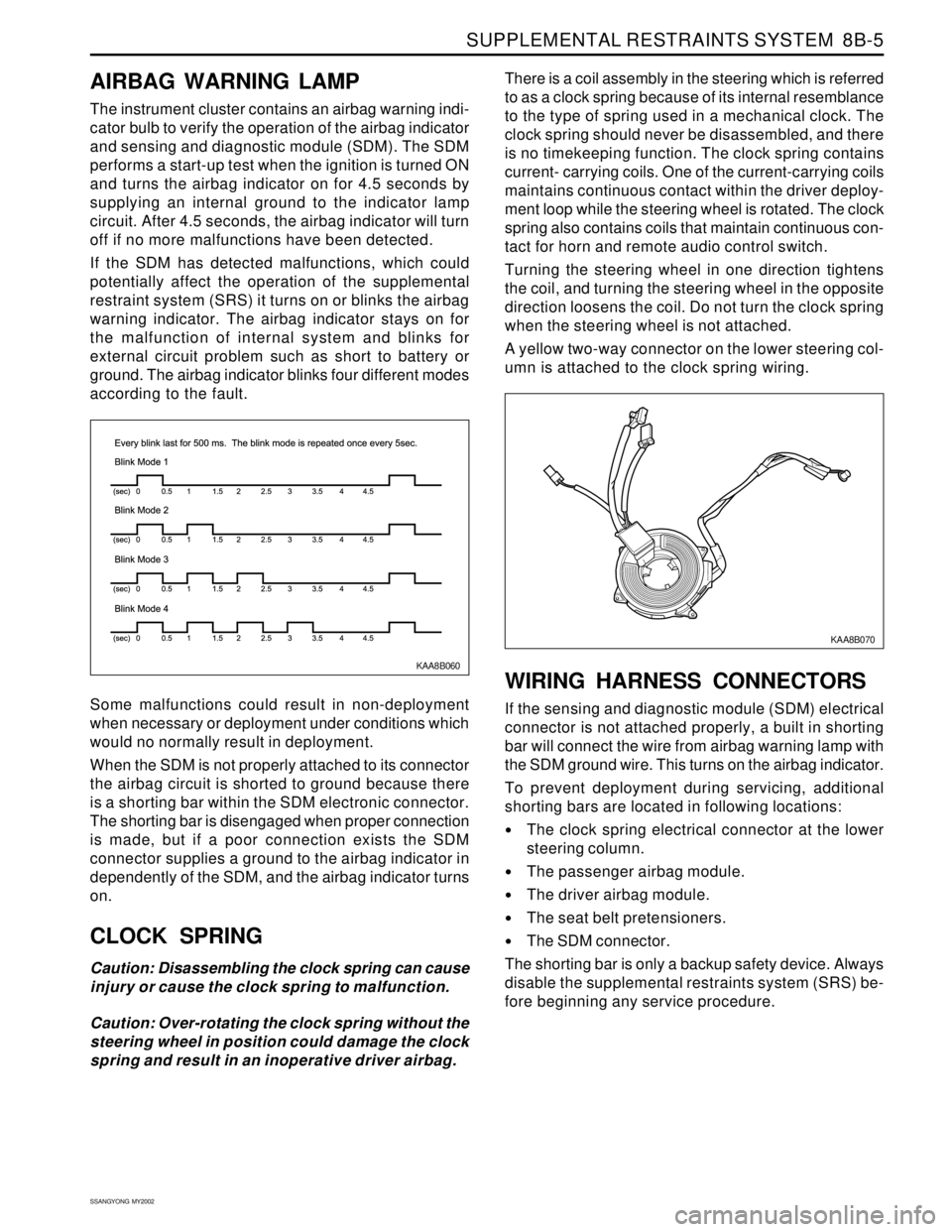
SUPPLEMENTAL RESTRAINTS SYSTEM 8B-5
SSANGYONG MY2002
KAA8B060
AIRBAG WARNING LAMP
The instrument cluster contains an airbag warning indi-
cator bulb to verify the operation of the airbag indicator
and sensing and diagnostic module (SDM). The SDM
performs a start-up test when the ignition is turned ON
and turns the airbag indicator on for 4.5 seconds by
supplying an internal ground to the indicator lamp
circuit. After 4.5 seconds, the airbag indicator will turn
off if no more malfunctions have been detected.
If the SDM has detected malfunctions, which could
potentially affect the operation of the supplemental
restraint system (SRS) it turns on or blinks the airbag
warning indicator. The airbag indicator stays on for
the malfunction of internal system and blinks for
external circuit problem such as short to battery or
ground. The airbag indicator blinks four different modes
according to the fault.
Some malfunctions could result in non-deployment
when necessary or deployment under conditions which
would no normally result in deployment.
When the SDM is not properly attached to its connector
the airbag circuit is shorted to ground because there
is a shorting bar within the SDM electronic connector.
The shorting bar is disengaged when proper connection
is made, but if a poor connection exists the SDM
connector supplies a ground to the airbag indicator in
dependently of the SDM, and the airbag indicator turns
on.
CLOCK SPRING
Caution: Disassembling the clock spring can cause
injury or cause the clock spring to malfunction.
Caution: Over-rotating the clock spring without the
steering wheel in position could damage the clock
spring and result in an inoperative driver airbag.There is a coil assembly in the steering which is referred
to as a clock spring because of its internal resemblance
to the type of spring used in a mechanical clock. The
clock spring should never be disassembled, and there
is no timekeeping function. The clock spring contains
current- carrying coils. One of the current-carrying coils
maintains continuous contact within the driver deploy-
ment loop while the steering wheel is rotated. The clock
spring also contains coils that maintain continuous con-
tact for horn and remote audio control switch.
Turning the steering wheel in one direction tightens
the coil, and turning the steering wheel in the opposite
direction loosens the coil. Do not turn the clock spring
when the steering wheel is not attached.
A yellow two-way connector on the lower steering col-
umn is attached to the clock spring wiring.
WIRING HARNESS CONNECTORS
If the sensing and diagnostic module (SDM) electrical
connector is not attached properly, a built in shorting
bar will connect the wire from airbag warning lamp with
the SDM ground wire. This turns on the airbag indicator.
To prevent deployment during servicing, additional
shorting bars are located in following locations:
The clock spring electrical connector at the lower
steering column.
The passenger airbag module.
The driver airbag module.
The seat belt pretensioners.
The SDM connector.
The shorting bar is only a backup safety device. Always
disable the supplemental restraints system (SRS) be-
fore beginning any service procedure.
KAA8B070
Page 1596 of 2053
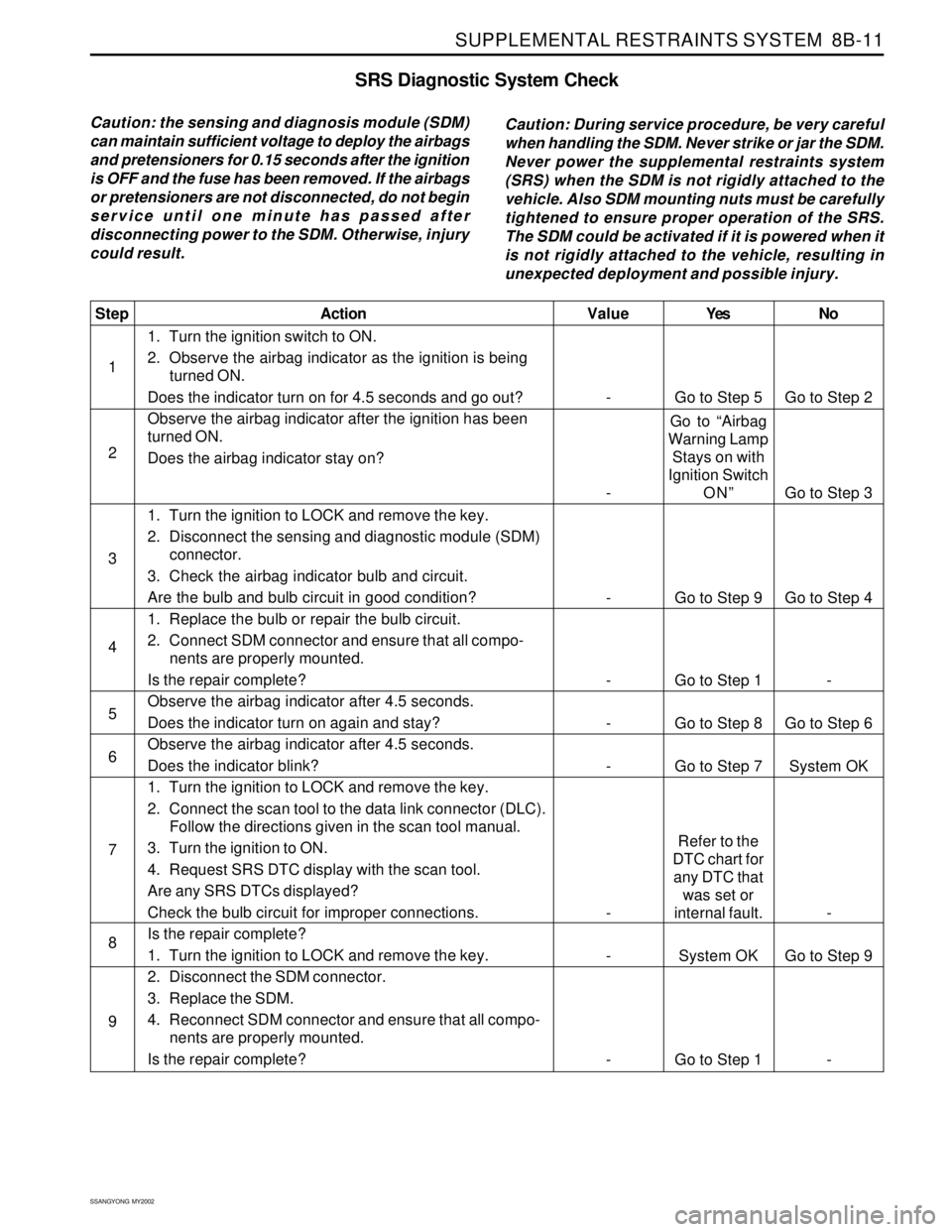
SUPPLEMENTAL RESTRAINTS SYSTEM 8B-11
SSANGYONG MY2002
SRS Diagnostic System Check
Caution: the sensing and diagnosis module (SDM)
can maintain sufficient voltage to deploy the airbags
and pretensioners for 0.15 seconds after the ignition
is OFF and the fuse has been removed. If the airbags
or pretensioners are not disconnected, do not begin
service until one minute has passed after
disconnecting power to the SDM. Otherwise, injury
could result.Caution: During service procedure, be very careful
when handling the SDM. Never strike or jar the SDM.
Never power the supplemental restraints system
(SRS) when the SDM is not rigidly attached to the
vehicle. Also SDM mounting nuts must be carefully
tightened to ensure proper operation of the SRS.
The SDM could be activated if it is powered when it
is not rigidly attached to the vehicle, resulting in
unexpected deployment and possible injury.
Yes
Go to Step 5
Go to “Airbag
Warning Lamp
Stays on with
Ignition Switch
ON”
Go to Step 9
Go to Step 1
Go to Step 8
Go to Step 7
Refer to the
DTC chart for
any DTC that
was set or
internal fault.
System OK
Go to Step 1No
Go to Step 2
Go to Step 3
Go to Step 4
-
Go to Step 6
System OK
-
Go to Step 9
- Value
-
-
-
-
-
-
-
-
-
Step
1
2
3
4
5
6
7
8
9Action
1. Turn the ignition switch to ON.
2. Observe the airbag indicator as the ignition is being
turned ON.
Does the indicator turn on for 4.5 seconds and go out?
Observe the airbag indicator after the ignition has been
turned ON.
Does the airbag indicator stay on?
1. Turn the ignition to LOCK and remove the key.
2. Disconnect the sensing and diagnostic module (SDM)
connector.
3. Check the airbag indicator bulb and circuit.
Are the bulb and bulb circuit in good condition?
1. Replace the bulb or repair the bulb circuit.
2. Connect SDM connector and ensure that all compo-
nents are properly mounted.
Is the repair complete?
Observe the airbag indicator after 4.5 seconds.
Does the indicator turn on again and stay?
Observe the airbag indicator after 4.5 seconds.
Does the indicator blink?
1. Turn the ignition to LOCK and remove the key.
2. Connect the scan tool to the data link connector (DLC).
Follow the directions given in the scan tool manual.
3. Turn the ignition to ON.
4. Request SRS DTC display with the scan tool.
Are any SRS DTCs displayed?
Check the bulb circuit for improper connections.
Is the repair complete?
1. Turn the ignition to LOCK and remove the key.
2. Disconnect the SDM connector.
3. Replace the SDM.
4. Reconnect SDM connector and ensure that all compo-
nents are properly mounted.
Is the repair complete?
Page 1597 of 2053
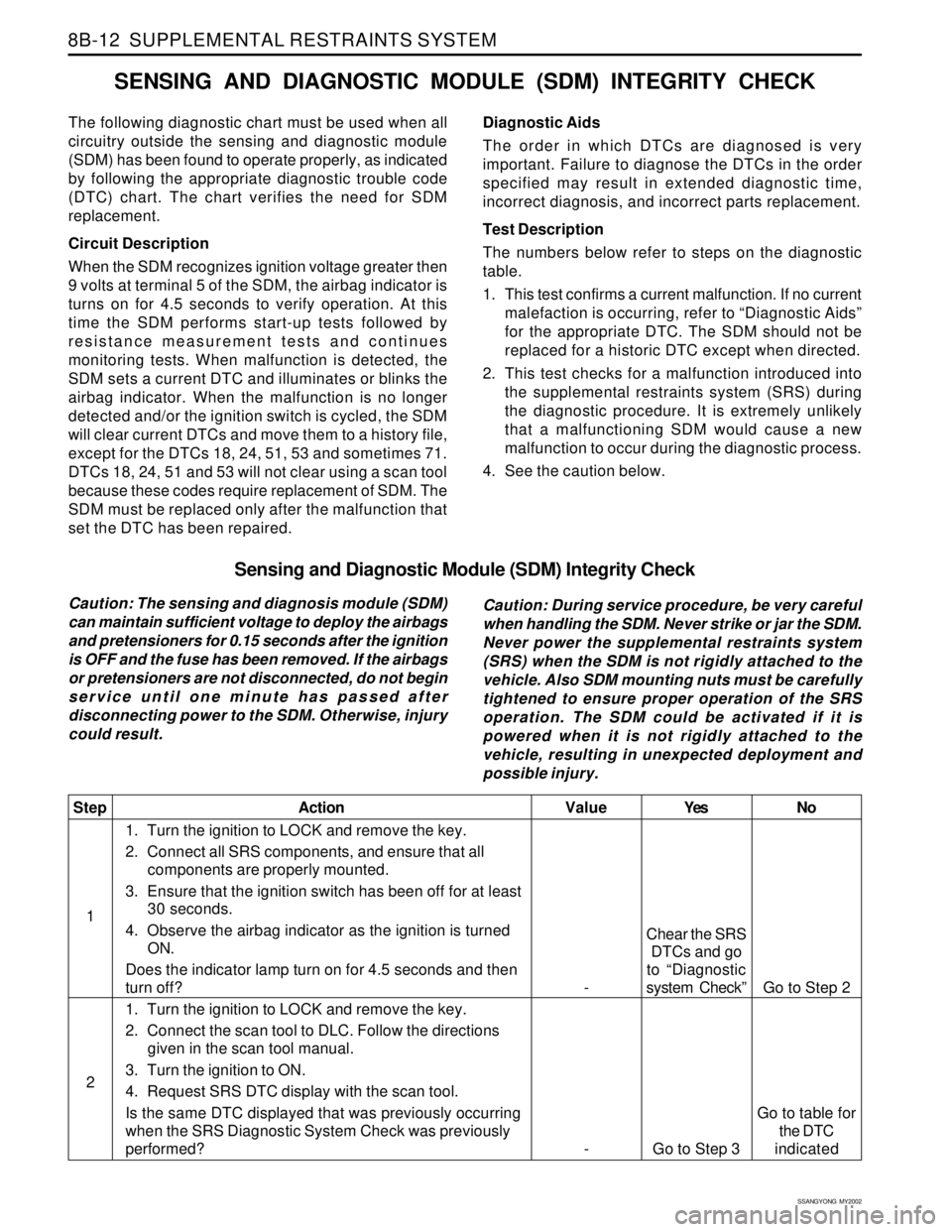
SSANGYONG MY2002
8B-12 SUPPLEMENTAL RESTRAINTS SYSTEM
Sensing and Diagnostic Module (SDM) Integrity Check
Caution: The sensing and diagnosis module (SDM)
can maintain sufficient voltage to deploy the airbags
and pretensioners for 0.15 seconds after the ignition
is OFF and the fuse has been removed. If the airbags
or pretensioners are not disconnected, do not begin
service until one minute has passed after
disconnecting power to the SDM. Otherwise, injury
could result.Caution: During service procedure, be very careful
when handling the SDM. Never strike or jar the SDM.
Never power the supplemental restraints system
(SRS) when the SDM is not rigidly attached to the
vehicle. Also SDM mounting nuts must be carefully
tightened to ensure proper operation of the SRS
operation. The SDM could be activated if it is
powered when it is not rigidly attached to the
vehicle, resulting in unexpected deployment and
possible injury.
Yes
Chear the SRS
DTCs and go
to “Diagnostic
system Check”
Go to Step 3No
Go to Step 2
Go to table for
the DTC
indicated Value
-
-
Step
1
2Action
1. Turn the ignition to LOCK and remove the key.
2. Connect all SRS components, and ensure that all
components are properly mounted.
3. Ensure that the ignition switch has been off for at least
30 seconds.
4. Observe the airbag indicator as the ignition is turned
ON.
Does the indicator lamp turn on for 4.5 seconds and then
turn off?
1. Turn the ignition to LOCK and remove the key.
2. Connect the scan tool to DLC. Follow the directions
given in the scan tool manual.
3. Turn the ignition to ON.
4. Request SRS DTC display with the scan tool.
Is the same DTC displayed that was previously occurring
when the SRS Diagnostic System Check was previously
performed?
SENSING AND DIAGNOSTIC MODULE (SDM) INTEGRITY CHECK
The following diagnostic chart must be used when all
circuitry outside the sensing and diagnostic module
(SDM) has been found to operate properly, as indicated
by following the appropriate diagnostic trouble code
(DTC) chart. The chart verifies the need for SDM
replacement.
Circuit Description
When the SDM recognizes ignition voltage greater then
9 volts at terminal 5 of the SDM, the airbag indicator is
turns on for 4.5 seconds to verify operation. At this
time the SDM performs start-up tests followed by
resistance measurement tests and continues
monitoring tests. When malfunction is detected, the
SDM sets a current DTC and illuminates or blinks the
airbag indicator. When the malfunction is no longer
detected and/or the ignition switch is cycled, the SDM
will clear current DTCs and move them to a history file,
except for the DTCs 18, 24, 51, 53 and sometimes 71.
DTCs 18, 24, 51 and 53 will not clear using a scan tool
because these codes require replacement of SDM. The
SDM must be replaced only after the malfunction that
set the DTC has been repaired.Diagnostic Aids
The order in which DTCs are diagnosed is very
important. Failure to diagnose the DTCs in the order
specified may result in extended diagnostic time,
incorrect diagnosis, and incorrect parts replacement.
Test Description
The numbers below refer to steps on the diagnostic
table.
1. This test confirms a current malfunction. If no current
malefaction is occurring, refer to “Diagnostic Aids”
for the appropriate DTC. The SDM should not be
replaced for a historic DTC except when directed.
2. This test checks for a malfunction introduced into
the supplemental restraints system (SRS) during
the diagnostic procedure. It is extremely unlikely
that a malfunctioning SDM would cause a new
malfunction to occur during the diagnostic process.
4. See the caution below.
Page 1599 of 2053
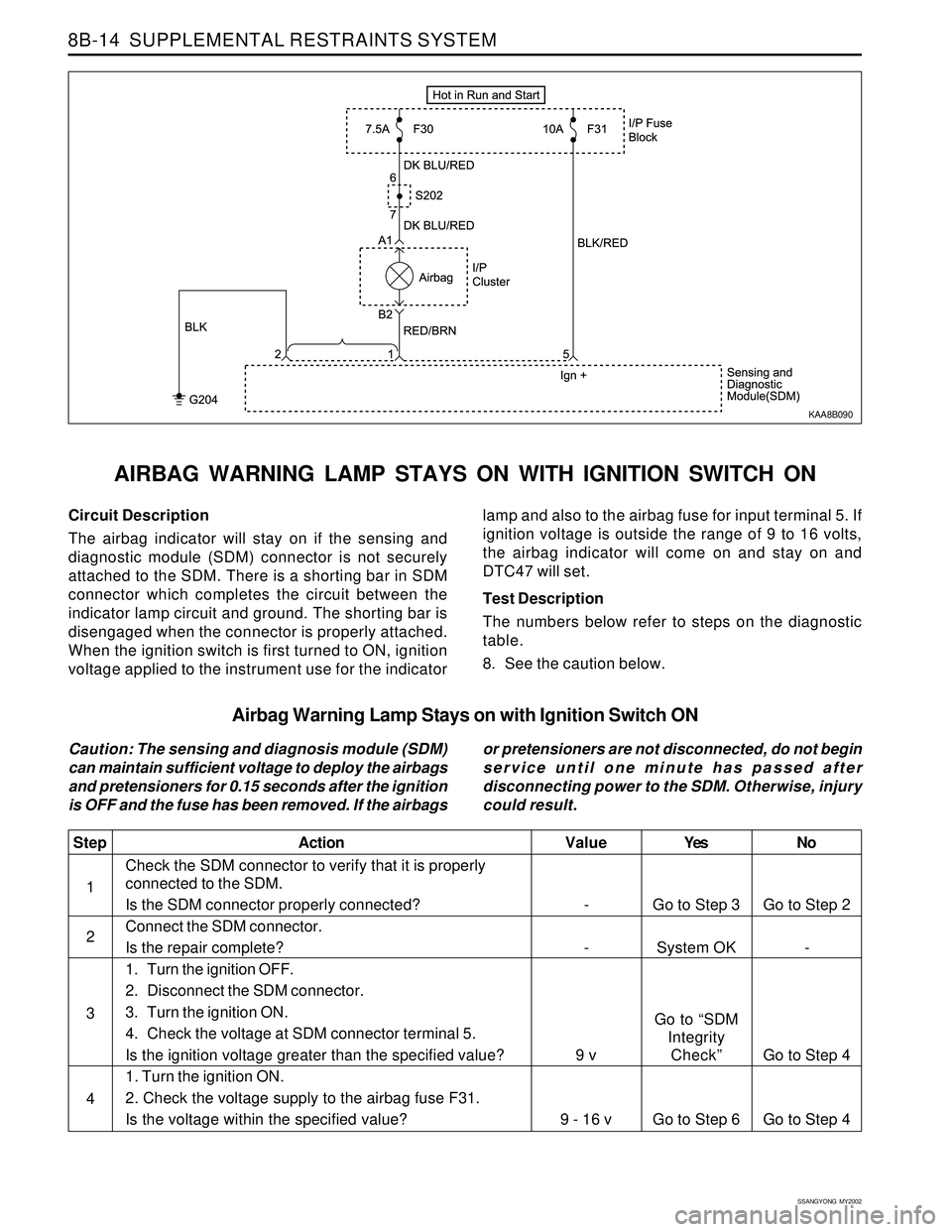
SSANGYONG MY2002
8B-14 SUPPLEMENTAL RESTRAINTS SYSTEM
Yes
Go to Step 3
System OK
Go to “SDM
Integrity
Check”
Go to Step 6No
Go to Step 2
-
Go to Step 4
Go to Step 4 Value
-
-
9 v
9 - 16 vStep
1
2
3
4Action
Check the SDM connector to verify that it is properly
connected to the SDM.
Is the SDM connector properly connected?
Connect the SDM connector.
Is the repair complete?
1. Turn the ignition OFF.
2. Disconnect the SDM connector.
3. Turn the ignition ON.
4. Check the voltage at SDM connector terminal 5.
Is the ignition voltage greater than the specified value?
1. Turn the ignition ON.
2. Check the voltage supply to the airbag fuse F31.
Is the voltage within the specified value?
Circuit Description
The airbag indicator will stay on if the sensing and
diagnostic module (SDM) connector is not securely
attached to the SDM. There is a shorting bar in SDM
connector which completes the circuit between the
indicator lamp circuit and ground. The shorting bar is
disengaged when the connector is properly attached.
When the ignition switch is first turned to ON, ignition
voltage applied to the instrument use for the indicator
AIRBAG WARNING LAMP STAYS ON WITH IGNITION SWITCH ON
lamp and also to the airbag fuse for input terminal 5. If
ignition voltage is outside the range of 9 to 16 volts,
the airbag indicator will come on and stay on and
DTC47 will set.
Test Description
The numbers below refer to steps on the diagnostic
table.
8. See the caution below.
KAA8B090
Airbag Warning Lamp Stays on with Ignition Switch ON
Caution: The sensing and diagnosis module (SDM)
can maintain sufficient voltage to deploy the airbags
and pretensioners for 0.15 seconds after the ignition
is OFF and the fuse has been removed. If the airbagsor pretensioners are not disconnected, do not begin
service until one minute has passed after
disconnecting power to the SDM. Otherwise, injury
could result.
Page 1601 of 2053
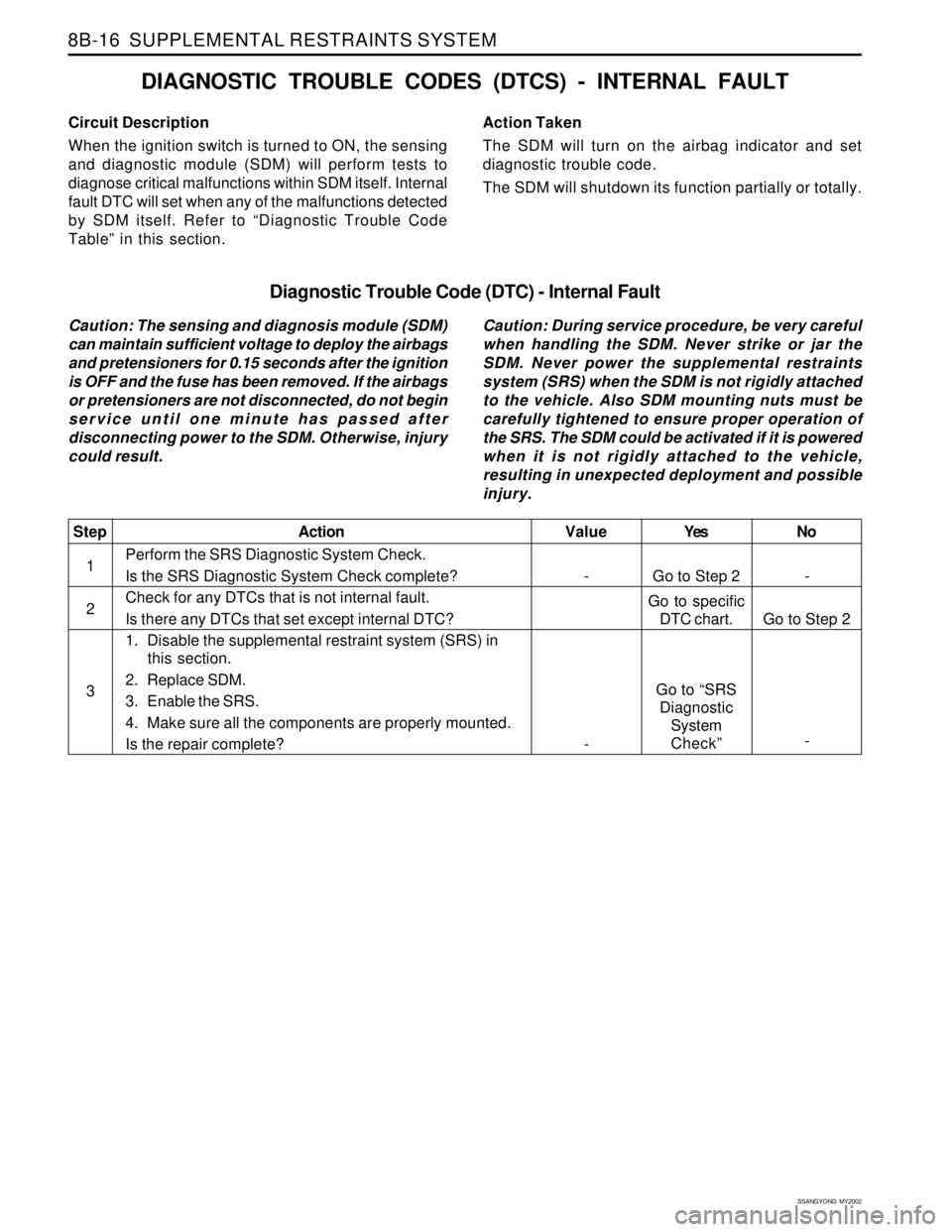
SSANGYONG MY2002
8B-16 SUPPLEMENTAL RESTRAINTS SYSTEM
Yes
Go to Step 2
Go to specific
DTC chart.
Go to “SRS
Diagnostic
System
Check”No
-
Go to Step 2
- Value
-
-Step
1
2
3Action
Perform the SRS Diagnostic System Check.
Is the SRS Diagnostic System Check complete?
Check for any DTCs that is not internal fault.
Is there any DTCs that set except internal DTC?
1. Disable the supplemental restraint system (SRS) in
this section.
2. Replace SDM.
3. Enable the SRS.
4. Make sure all the components are properly mounted.
Is the repair complete?
Circuit Description
When the ignition switch is turned to ON, the sensing
and diagnostic module (SDM) will perform tests to
diagnose critical malfunctions within SDM itself. Internal
fault DTC will set when any of the malfunctions detected
by SDM itself. Refer to “Diagnostic Trouble Code
Table” in this section.
DIAGNOSTIC TROUBLE CODES (DTCS) - INTERNAL FAULT
Action Taken
The SDM will turn on the airbag indicator and set
diagnostic trouble code.
The SDM will shutdown its function partially or totally.
Diagnostic Trouble Code (DTC) - Internal Fault
Caution: The sensing and diagnosis module (SDM)
can maintain sufficient voltage to deploy the airbags
and pretensioners for 0.15 seconds after the ignition
is OFF and the fuse has been removed. If the airbags
or pretensioners are not disconnected, do not begin
service until one minute has passed after
disconnecting power to the SDM. Otherwise, injury
could result.Caution: During service procedure, be very careful
when handling the SDM. Never strike or jar the
SDM. Never power the supplemental restraints
system (SRS) when the SDM is not rigidly attached
to the vehicle. Also SDM mounting nuts must be
carefully tightened to ensure proper operation of
the SRS. The SDM could be activated if it is powered
when it is not rigidly attached to the vehicle,
resulting in unexpected deployment and possible
injury.